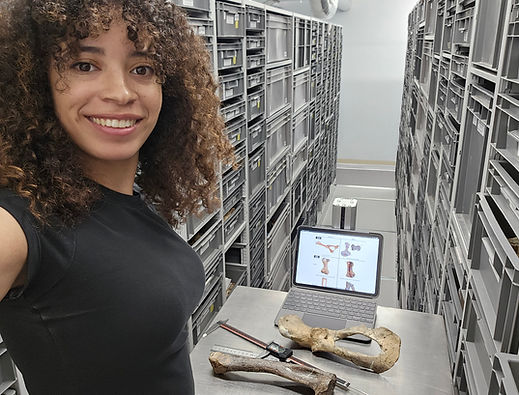.jpg)
Research
My broad research questions relate to the functional morphological controls which facilitate, enable, or constrain major evolutionary transitions, particularly the controls of locomotion in evolving from land to water.
I also study the the biomechanics and kinematics of aquatic tetrapods and dabble in mass extinctions and recovery, particularly the end-Triassic and end-Permian.
.jpg)

Publications
Alison T. Cribb, Kiersten K. Formoso, C. Henrik Woolley, James Beech, Shannon Brophy, Paul Byrne, Victoria C. Cassady, Amanda L. Godbold, Ekaterina Larina, Philip-peter Maxeiner, Yun-Hsin Wu, Frank A. Corsetti and David J. Bottjer. 2023. Contrasting terrestrial and marine ecospace dynamics after the end-Triassic mass extinction event, Proceedings B. https://doi.org/10.1098/rspb.2023.2232
Kiersten K. Formoso, Michael B. Habib, Jorge Velez-Juarbe. 2023. The role of locomotory ancestry on secondarily aquatic transitions, Integrative and Comparative Biology. https://doi.org/10.1093/icb/icad112
Paul C. Sereno, Nathan Myhrvold, Donald M. Henderson, Frank E. Fish, Daniel Vidal, Stephanie L. Baumgart, Tyler M. Keillor, Kiersten K. Formoso, Lauren L. Conroy. 2022. Spinosaurus is not an aquatic dinosaur, eLife. https://doi.org/10.7554/eLife.80092
Griffin, C.T., Stocker, M.R., Colleary, C., Stefanic, C.M., Lessner, E.J., Riegler, M., Formoso, K., Koeller, K. and Nesbitt, S.J. 2021, Assessing ontogenetic maturity in extinct saurian reptiles, Biology Reviews. https://doi.org/10.1111/brv.12666
Formoso, Kiersten K., Nesbitt, Sterling J., Pritchard, Adam C., Stocker, Michelle R., and Parker, William G. 2019. A long-necked tanystropheid from the Middle Triassic Moenkopi Formation (Anisian) provides insights into the ecology and biogeography of tanystropheids. Palaeontologia Electronica. https://doi.org/10.26879/988 palaeo-electronica.org/content/2019/2824-long-necked-moenkopi-tanystropheid
.png)




